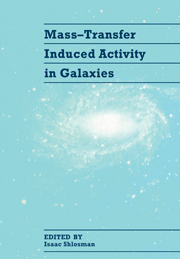Book contents
- Frontmatter
- Contents
- Preface
- List of Participants
- I INTRODUCTION
- II THE INNER PARSEC
- III THE CIRCUMNUCLEAR REGION
- IV GAS DYNAMICS AND STAR FORMATION IN BARRED AND NORMAL GALAXIES
- V NUCLEAR GAS AND LARGE-SCALE PROPERTIES OF AGN AND STARBURST HOSTS
- VI HOST GALAXY-AGN-NUCLEAR STARBURST CONNECTION
- Starbursts, Quasars, and their Environments (Invited paper) 234
- Nuclear Fueling in Two-Component Star-Gas Disks (Invited paper) 251
- Radio Loud Far-Infrared Galaxies 263
- Massive Central Black Holes as Generators of Chaos and Drivers of Large-Scale Dynamics
- Self-Gravitating Gas Dynamics: Growing Monsters and Fueling Starburstsin Disk Galaxies
- Radial Inflows in Disk Galaxies: Effects of Star Formation 279
- Self-Gravitating Gas Dynamics in a Galactic Central Region
- Nuclear Inflow under the Action of Instabilities
- Mid-IR Imaging of Interacting and Non-Interacting AGNs (Poster paper)
- Imaging of MBG Starbursts: Preliminary Results (Poster paper)
- Compact Extranuclear Structures of Mkn 298 (Poster paper)
- NGC 6814: a Very Normal Looking AGN Host Galaxy (Poster paper)
- ROSAT PSPC Observations of NGC 3079 (Poster paper)
- MK 231: AGN vs. Starburst? Steps Toward a Model (Poster paper)
- Extended Starburst Activity Induced by the Central AGN: a Model for NGC 1068 (Poster paper)
- NGC 2782, NGC 4102 and NGC 6764: Evidence for Starburst-Driven Winds
- AGN Winds and Nuclear Starbursts (Poster paper)
- VII GALAXY INTERACTIONS AND INDUCED ACTIVITY
- VIII GAS DYNAMICS IN ELLIPTICALS
- IX AGN AND STARBURST HOSTS AT LARGE REDSHIFTS
- X CONFERENCE SUMMARY
- Subject Index
- Object Index
- Author Index
Compact Extranuclear Structures of Mkn 298 (Poster paper)
Published online by Cambridge University Press: 05 May 2010
- Frontmatter
- Contents
- Preface
- List of Participants
- I INTRODUCTION
- II THE INNER PARSEC
- III THE CIRCUMNUCLEAR REGION
- IV GAS DYNAMICS AND STAR FORMATION IN BARRED AND NORMAL GALAXIES
- V NUCLEAR GAS AND LARGE-SCALE PROPERTIES OF AGN AND STARBURST HOSTS
- VI HOST GALAXY-AGN-NUCLEAR STARBURST CONNECTION
- Starbursts, Quasars, and their Environments (Invited paper) 234
- Nuclear Fueling in Two-Component Star-Gas Disks (Invited paper) 251
- Radio Loud Far-Infrared Galaxies 263
- Massive Central Black Holes as Generators of Chaos and Drivers of Large-Scale Dynamics
- Self-Gravitating Gas Dynamics: Growing Monsters and Fueling Starburstsin Disk Galaxies
- Radial Inflows in Disk Galaxies: Effects of Star Formation 279
- Self-Gravitating Gas Dynamics in a Galactic Central Region
- Nuclear Inflow under the Action of Instabilities
- Mid-IR Imaging of Interacting and Non-Interacting AGNs (Poster paper)
- Imaging of MBG Starbursts: Preliminary Results (Poster paper)
- Compact Extranuclear Structures of Mkn 298 (Poster paper)
- NGC 6814: a Very Normal Looking AGN Host Galaxy (Poster paper)
- ROSAT PSPC Observations of NGC 3079 (Poster paper)
- MK 231: AGN vs. Starburst? Steps Toward a Model (Poster paper)
- Extended Starburst Activity Induced by the Central AGN: a Model for NGC 1068 (Poster paper)
- NGC 2782, NGC 4102 and NGC 6764: Evidence for Starburst-Driven Winds
- AGN Winds and Nuclear Starbursts (Poster paper)
- VII GALAXY INTERACTIONS AND INDUCED ACTIVITY
- VIII GAS DYNAMICS IN ELLIPTICALS
- IX AGN AND STARBURST HOSTS AT LARGE REDSHIFTS
- X CONFERENCE SUMMARY
- Subject Index
- Object Index
- Author Index
Summary
RESULTS AND DISCUSSION
Mkn 298 is known as a morphologically peculiar system (Fig. 1), showing a chain (c, d, e) of small compact blue emitting regions (Stockton 1972) aligned on its eastern side up to ∼ 80 arcsec from the main body of the galaxy. These regions are aligned, with a tail (b) resembling a spiral arm located on the eastern side of the galaxy (a). On the western side a very faint trace of spiral arm is also visible, d and e are characterized by an emission line spectrum, while spectra of c do not show any trace of either emission or absorption (Stockton 1972; Metik and Pronik 1982).
The contour maps of the extended emission lines Hα, Hβ and [OIII]λλ4959, 5007 have been used to isolate six different emitting regions in a and b. Each strip on the 2D-spectrum has then been mashed into a ID-spectrum and the diagnostic line ratios proposed by Veilleux and Osterbrock (1987) have been plotted in the diagnostic diagrams giving [OIII]λ5007/Hβ versus [SII]λλ6716+6731/Hα, [N II]λ6583/Hα, [OI]λ6300/Hα. The effect of reddening has been evaluated from the Hα/Hβ ratio using the Whitford (1958) reddening curve as parameterized by Miller and Mat hews (1972) and adopting the intrinsic ratio 2.81.
- Type
- Chapter
- Information
- Mass-Transfer Induced Activity in Galaxies , pp. 298 - 299Publisher: Cambridge University PressPrint publication year: 1994

